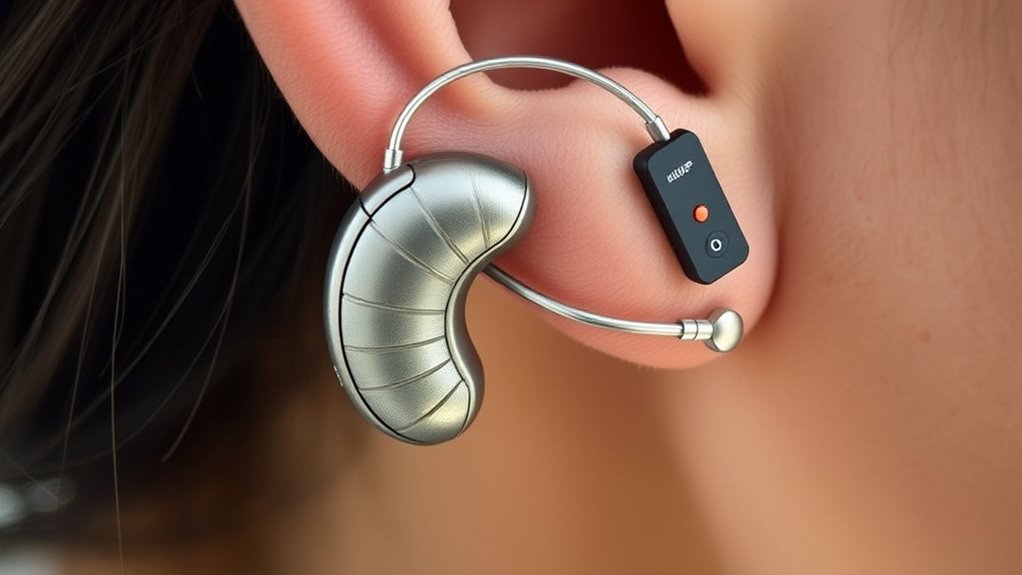A cochlear implant is a small electronic device designed to help people with severe hearing loss or deafness perceive sound. It works by bypassing damaged parts of your ear and directly stimulating the auditory nerve with electrical signals. The device includes external and internal parts, with a surgical procedure involved in placement. While it improves hearing, benefits vary, and ongoing care is necessary. To learn more about how cochlear implants work and their benefits, continue exploring this topic.
Key Takeaways
- A cochlear implant is an electronic device that bypasses damaged ear parts to stimulate the auditory nerve directly.
- It consists of external and internal components, including a microphone, processor, receiver, and electrodes.
- The device captures sound, processes it into electrical signals, and stimulates the auditory nerve for sound perception.
- Candidates typically have severe to profound hearing loss not helped by hearing aids, requiring evaluation and surgery.
- Regular maintenance, follow-up, and auditory training are essential for optimal device performance and hearing benefits.
What Is a Cochlear Implant?

Have you ever wondered how some people hear even when they can’t hear naturally? A cochlear implant is a small electronic device that helps individuals with severe hearing loss or deafness. Unlike hearing aids, which amplify sound, cochlear implants bypass damaged parts of your ear and directly stimulate the auditory nerve. The device consists of two main parts: an external processor that captures sound and converts it into electrical signals, and an internal implant that sends these signals to your brain. This process allows you to perceive sound and understand speech, even if your own ears can’t hear well. Cochlear implants don’t restore normal hearing, but they profoundly improve your ability to communicate and connect with the world around you. Understanding hearing loss can help you better appreciate how cochlear implants provide a valuable solution.
How Do Cochlear Implants Work?
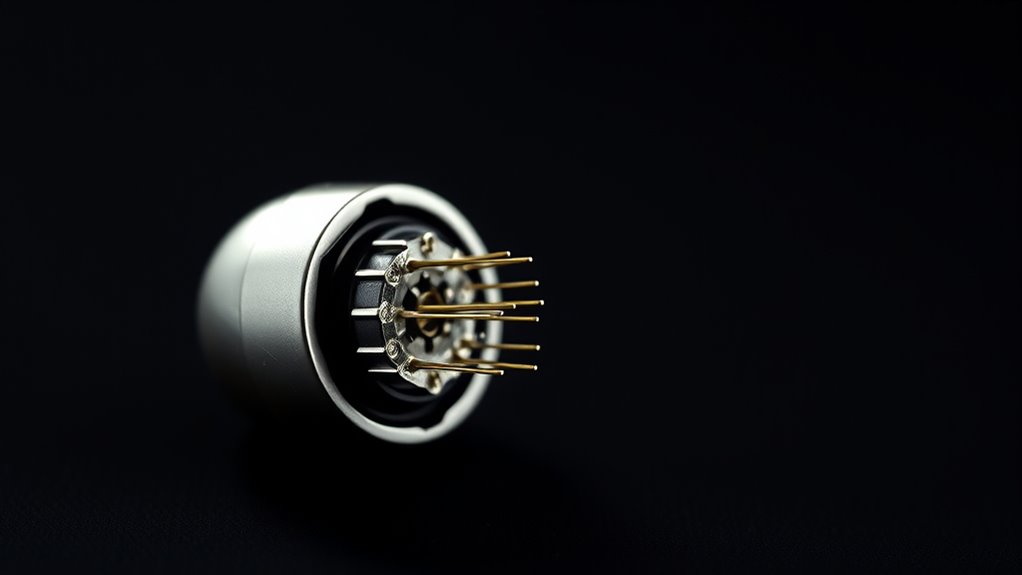
Cochlear implants work by converting sound into electrical signals that directly stimulate the auditory nerve, bypassing damaged parts of your ear. When you hear a sound, the microphone picks it up and sends the information to the speech processor. The processor then analyzes the sound and creates digital signals. These signals are transmitted to the transmitter, which sends them through the skin to the implanted receiver. The receiver converts these signals into electrical impulses and sends them along the electrode array inserted into your cochlea. The electrodes stimulate the auditory nerve fibers, sending signals to your brain that it interprets as sound. This process allows you to perceive sound, even if your inner ear is damaged or nonfunctional. Understanding cochlear implant technology involves a combination of biomedical engineering and auditory science to optimize sound perception.
Who Can Benefit From a Cochlear Implant?

Wondering if you’re a good candidate for a cochlear implant? You might be if you have severe to profound hearing loss in both ears and haven’t found success with hearing aids. Cochlear implants are especially beneficial for those who:
If you have severe to profound hearing loss and haven’t benefited from hearing aids, a cochlear implant might help.
- Struggle to understand speech even with hearing aids
- Experience significant difficulty in noisy environments
- Have a stable health condition that allows surgery
Even if you’re older or have been deaf for a long time, you may still gain improved hearing and communication. It’s essential to consult with an audiologist or ENT specialist to evaluate your specific situation. Candidates typically undergo assessments to determine if the implant can help improve your hearing and quality of life. Inspirational quotes about fatherhood can serve as motivation to embrace new communication possibilities and support systems.
The Components of a Cochlear Implant System
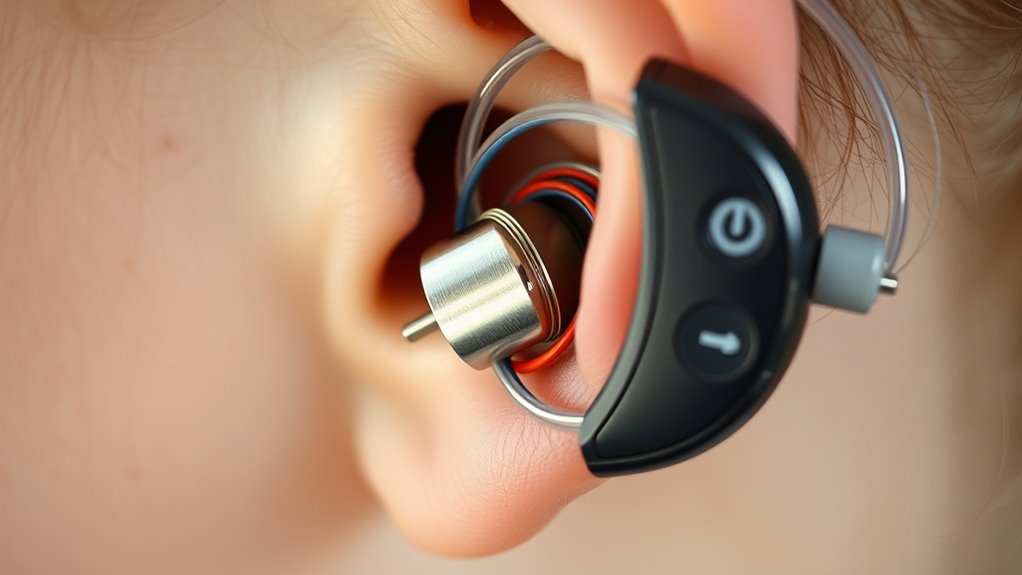
Your cochlear implant system has essential parts that work together to restore hearing. The external processor captures and processes sounds, while the internal electrode array stimulates your auditory nerve. Signal transmission connects these components, ensuring seamless communication between them. Vetted components are crucial for optimal function and durability.
External Processor Functionality
The external processor is a vital component of a cochlear implant system, responsible for capturing incoming sounds and converting them into digital signals. It picks up sounds through a microphone and processes them to match your hearing needs. This device can be customized with programs tailored to different environments, like quiet or noisy settings. Its features include wireless connectivity, allowing you to stream audio directly from devices. The processor also amplifies and filters sounds to improve clarity and reduce background noise. Proper programming is essential to ensure the device functions effectively across various listening situations.
Internal Electrode Array
The internal electrode array is a essential part of a cochlear implant that directly stimulates your auditory nerve. It consists of thin, flexible wires with multiple electrodes along their length. Once implanted into your cochlea, these electrodes convert electrical signals into impulses your brain interprets as sound. The array is carefully inserted into the cochlear spiral to target specific nerve fibers, allowing for detailed sound perception. Its design guarantees minimal trauma during placement and promotes long-term stability. The electrodes work with the external processor to transmit sound information, enabling you to hear speech, music, and environmental sounds. Proper positioning of the electrode array is paramount for ideal hearing performance, making it a key component in restoring auditory function. Additionally, advancements in remote collaboration have facilitated better training and precision during surgical procedures, improving outcomes for patients.
Signal Transmission Method
Signal transmission in a cochlear implant involves a seamless flow of electrical signals from the external sound processor to the internal electrode array. The external microphone captures sound, which the processor converts into digital signals. These signals are then sent to the transmitter coil that rests behind your ear. The coil transmits the signals wirelessly to the internal receiver/stimulator. From there, the signals are directed to the electrode array, stimulating your auditory nerve to produce sound perceptions. Key components include:
- Wireless transmission via radio frequency (RF) signals
- Conversion of sound into electrical impulses
- Precise targeting of individual electrodes for accurate sound mapping
- The technology involved ensures minimal signal loss and clear audio quality.
This efficient process guarantees you receive clear auditory input, helping you interpret sounds and speech effectively.
The Process of Getting a Cochlear Implant

Deciding to get a cochlear implant involves several important steps to make certain it’s the right choice for you. First, you’ll undergo a thorough evaluation with an audiologist and cochlear implant team. They’ll assess your hearing, medical history, and overall health. Next, you’ll have imaging tests like CT or MRI scans to examine your ear and skull structure. If approved, you’ll attend counseling to understand the procedure and set expectations. The surgery typically takes a few hours, and recovery lasts a few weeks. Post-surgery, you’ll begin fitting and programming your device. Here’s a quick overview:
| Step | Description | Duration |
|---|---|---|
| Evaluation | Hearing tests and medical assessment | 1-2 weeks |
| Imaging | CT/MRI scans | 1 day |
| Surgery | Implant placement | 2-3 hours |
| Healing & Adjustment | Recovery and initial device fitting | Several weeks |
| Follow-up & Programming | Fine-tuning the device | Ongoing |
A thorough understanding of the evaluation process is crucial to ensure the suitability of a cochlear implant.
Benefits and Limitations of Cochlear Implants
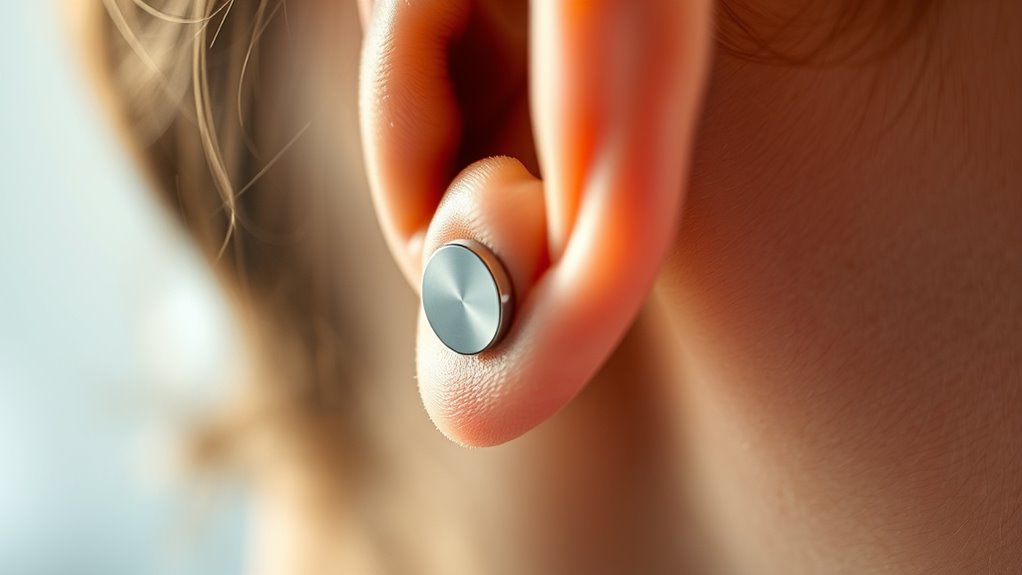
Understanding the benefits and limitations of cochlear implants helps you make an informed decision about whether this technology suits your needs. These devices can profoundly improve hearing, allowing you to perceive sounds and speech more clearly. They can also enhance your ability to communicate and reconnect with your environment. However, limitations exist. Not everyone experiences the same level of benefit, and some may still struggle with understanding speech in noisy settings. Additionally, cochlear implants require surgery and regular maintenance. Recognizing angel number meanings can also provide emotional support during the adjustment process. Key considerations include: – Variable outcomes depending on age and hearing history – The need for ongoing auditory training – Possible issues with sound quality and feedback Weighing these factors helps you determine if a cochlear implant aligns with your lifestyle and expectations.
Potential Risks and Complications
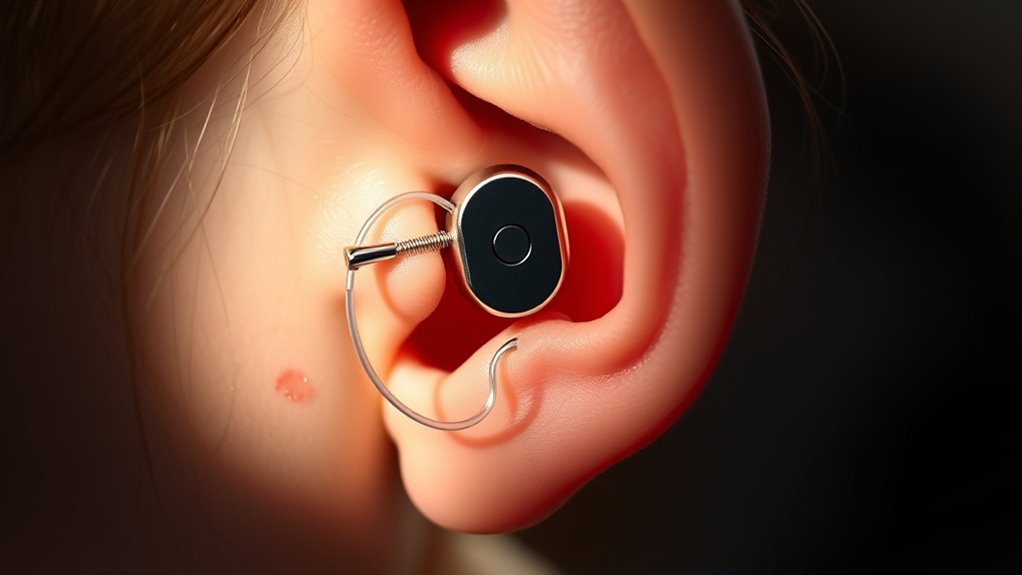
While cochlear implants can considerably improve hearing, they also carry potential risks and complications you should consider. Infection is a concern, as surgery involves opening your skull and inserting the device, which might lead to swelling or infection. There’s also a risk of damage to surrounding structures, such as the facial nerve, which could cause weakness or paralysis. Some people experience dizziness, vertigo, or balance issues after surgery. In rare cases, the implant might not work as expected, requiring additional surgeries or adjustments. You might also face issues with device failure or malfunction over time, leading to the need for repairs or replacements. Additionally, cybersecurity vulnerabilities related to the device’s software or connectivity could pose risks if not properly managed. It’s important to weigh these risks against the potential benefits and discuss them thoroughly with your healthcare provider before proceeding.
Caring for and Maintaining Your Implant
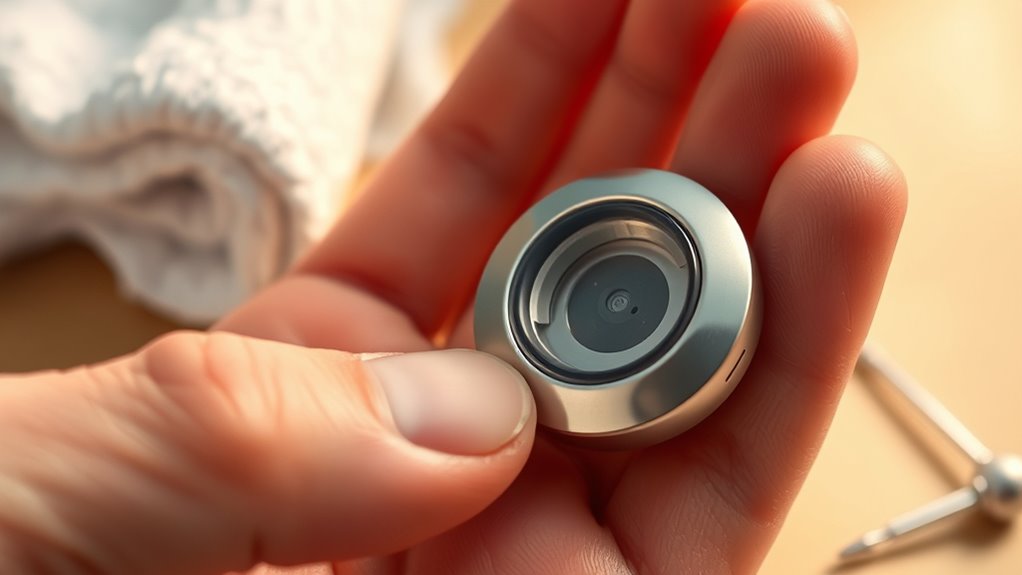
Taking care of your cochlear implant is essential for its ideal performance. You should follow daily cleaning routines, manage your battery properly, and keep up with regular checkups. These simple steps help guarantee your implant stays in top shape and functions smoothly.
Daily Cleaning Procedures
Regular daily cleaning is essential to keep your cochlear implant functioning properly and to prevent infections. You should gently clean the external parts of your device daily. Use a soft, damp cloth to wipe down the processor, avoiding water contact with the internal components. Remove any debris or earwax around the earhook and magnet to ensure clear sound transmission.
Remember these key points:
- Avoid using harsh chemicals or alcohol on your device.
- Check for and remove any earwax buildup regularly.
- Keep the device dry and store it in a safe, clean area when not in use.
Battery Care Tips
Proper battery care is essential to guarantee your cochlear implant remains reliable and performs effectively. Always use the recommended batteries and avoid mixing old and new ones, as this can affect performance. Store batteries in a cool, dry place away from direct sunlight and heat sources to prevent damage. When changing batteries, do so in a clean environment to prevent dirt or moisture from contaminating the device. Turn off your implant when not in use for extended periods to conserve battery life. Keep spare batteries on hand to avoid interruptions. Regularly check your battery indicator to monitor power levels, and replace batteries promptly when they’re low. Proper handling and storage guarantee your implant functions smoothly and prolongs battery life.
Regular Checkups Schedule
Scheduling routine checkups is essential for guaranteeing your cochlear implant functions ideally and remains in good condition. Regular visits allow your audiologist to monitor performance, update software, and address any issues early. These checkups typically include a thorough inspection of the external parts, testing of the device’s responsiveness, and verification of proper functioning. Staying consistent with your appointments helps prevent unexpected failures and ensures you get the most out of your implant. During visits, your audiologist may:
- Adjust settings for optimal hearing
- Check for signs of wear or damage
- Provide guidance on troubleshooting and maintenance
Frequently Asked Questions
How Long Does It Take to Adapt to a Cochlear Implant?
Adapting to a cochlear implant varies for each person, but generally, it takes a few months. You might notice improvements within the first few weeks, but full adaptation can take six months or longer. During this time, your brain learns to interpret the new sounds. Patience and consistent use are key. Keep working closely with your audiologist, and stay positive—you’ll likely find your hearing gets better with time.
Can Children With Cochlear Implants Learn to Speak Naturally?
You might worry if children with cochlear implants can learn to speak naturally, and the answer is yes. Many kids do develop clear, expressive speech, especially with early implantation and consistent therapy. While progress varies, your child’s potential to speak naturally is very real. With patience, support, and professional guidance, you’ll see remarkable improvements, and your child can enjoy the full richness of spoken language just like their peers.
Are Cochlear Implants Suitable for People With Certain Medical Conditions?
You may wonder if cochlear implants suit people with specific medical conditions. Generally, your doctor evaluates your overall health, ear health, and medical history to determine suitability. Conditions like active infections, certain neurological issues, or severe ear malformations might affect candidacy or require additional treatment. It is crucial to consult with a specialist who can assess your unique situation and advise whether a cochlear implant is a safe and effective option for you.
What Costs Are Involved Beyond the Implant Surgery?
Cost concerns can cause confusion, but beyond the implant surgery, you’ll face several expenses. You might pay for pre-surgery consultations, post-surgery programming, and regular check-ups. Additionally, you’ll need to budget for maintenance, batteries, and repairs. Some costs may be covered by insurance or assistance programs, but it’s wise to weigh these expenses carefully. Planning for these predictable, persistent payments helps prevent financial fuss and future frustrations.
How Does Age Affect Cochlear Implant Effectiveness?
Age plays a significant role in how well you might respond to a cochlear implant. If you’re younger, your brain is more adaptable, making it easier to learn how to interpret new sounds. Older adults might face some challenges due to less neural plasticity. However, many people of all ages experience improved hearing and quality of life. Your individual health and hearing history are also important factors in how effective the implant will be.
Conclusion
A cochlear implant is your gateway to renewed sound, opening a world that once seemed silent. With proper care and understanding, you can navigate its benefits and challenges like a seasoned sailor steering through calm and storm. Embrace this technology as a trusted companion on your journey to better hearing, knowing that, with patience and attention, it can transform your silence into a symphony of life’s sounds.
